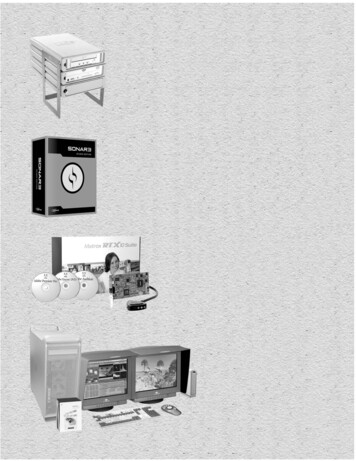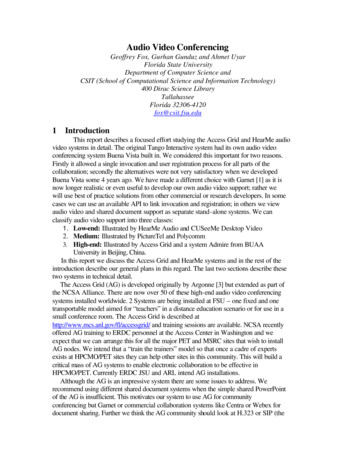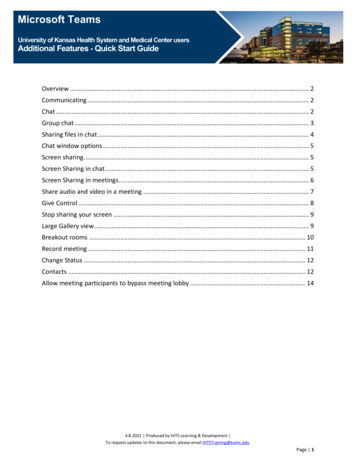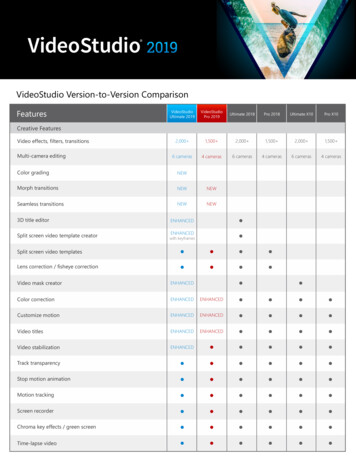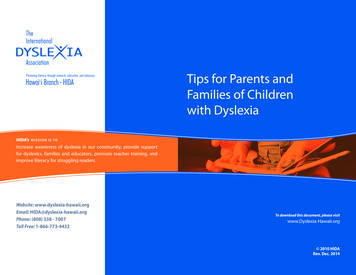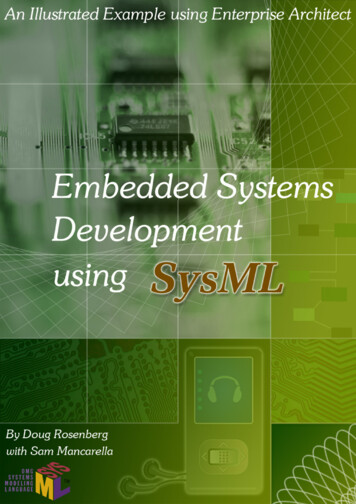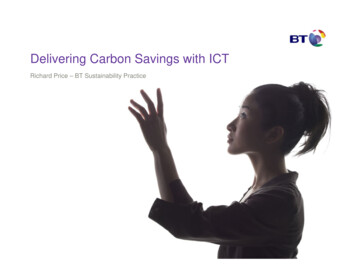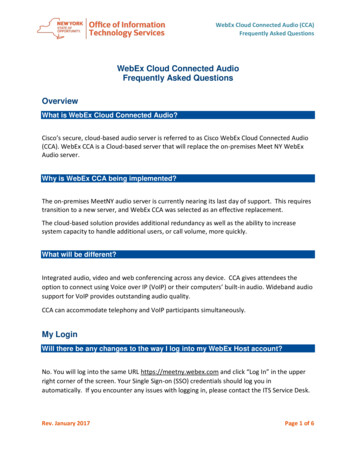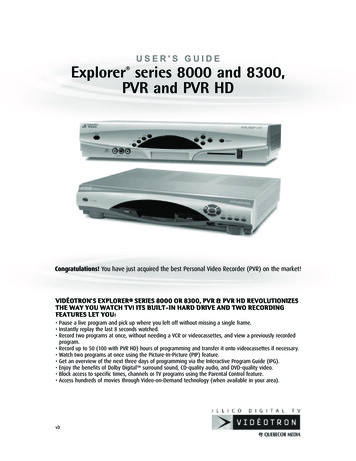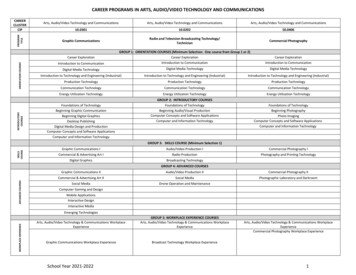
Transcription
CAREER PROGRAMS IN ARTS, AUDIO/VIDEO TECHNOLOGY AND COMMUNICATIONSINTRODCUTORYCOURSESORIENTATION COURSESPROGRAMTITLECAREERCLUSTERCIPArts, Audio/Video Technology and CommunicationsArts, Audio/Video Technology and CommunicationsArts, Audio/Video Technology and Communications10.030110.020250.0406Graphic CommunicationsRadio and Television Broadcasting Technology/TechnicianCommercial PhotographyCareer ExplorationIntroduction to CommunicationGROUP 1: ORIENTATION COURSES (Minimum Selection: One course from Group 1 or 2)Career ExplorationIntroduction to CommunicationCareer ExplorationIntroduction to CommunicationDigital Media TechnologyDigital Media TechnologyDigital Media TechnologyIntroduction to Technology and Engineering (Industrial)Introduction to Technology and Engineering (Industrial)Introduction to Technology and Engineering (Industrial)Production TechnologyProduction TechnologyProduction TechnologyCommunication TechnologyCommunication TechnologyCommunication TechnologyEnergy Utilization TechnologyEnergy Utilization TechnologyEnergy Utilization TechnologyFoundations of TechnologyBeginning Graphic CommunicationBeginning Digital GraphicsDesktop PublishingDigital Media Design and ProductionComputer Concepts and Software ApplicationsComputer and Information TechnologyGROUP 2: INTRODUCTORY COURSESFoundations of TechnologyBeginning Audio/Visual ProductionComputer Concepts and Software ApplicationsComputer and Information TechnologyFoundations of TechnologyBeginning PhotographyPhoto ImagingComputer Concepts and Software ApplicationsComputer and Information TechnologySKILLSCOURSEGROUP 3: SKILLS COURSE (Minimum Selection 1)Graphic Communications IAudio/Video Production ICommercial Photography ICommercial & Advertising Art IRadio ProductionPhotography and Printing TechnologyDigital GraphicsBroadcasting TechnologyADVANCED COURSESGROUP 4: ADVANCED COURSESGraphic Communications IIAudio/Video Production IICommercial Photography IICommercial & Advertising Art IISocial MediaPhotographic Laboratory and DarkroomSocial MediaDrone Operation and MaintenanceComputer Gaming and DesignMobile ApplicationsInteractive DesignInteractive MediaWORKPLACE EXPERIENCEEmerging TechnologiesArts, Audio/Video Technology & Communications WorkplaceExperienceGROUP 5: WORKPLACE EXPERIENCE COURSESArts, Audio/Video Technology & Communications WorkplaceExperienceGraphic Communications Workplace ExperienceBroadcast Technology Workplace ExperienceSchool Year 2021-2022Arts, Audio/Video Technology & Communications WorkplaceExperienceCommercial Photography Workplace Experience1
CAREER PROGRAMS IN ARTS, AUDIO/VIDEO TECHNOLOGY AND COMMUNICATIONSA quality CTE program delivers all required elements of Illinois’ definition of Size, Scope, Quality. CTE program elements include: a sequence of courses, each educational entity offering approvedcourses provides assurance that the course content includes at a minimum the State course description, meets the State’s minimum requirements for course offerings by program, curriculumaligned to state recognized learning standards & industry standards, career pathway guidance, resources to support program/course delivery (licensed & qualified staff, appropriate facilities,adequate equipment, instructional materials, work-based learning experiences, special populations support services, an active affiliated CTSO chapter), articulation/dual credit agreements,documentation of state agency certification or licensing requirements for occupations regulated by law or licensure, & content which prepare students for reflective of current labor & opportunityfor workplace experience or a structured capstone course. Orientation courses are suggested to be taught at the prior-to-secondary or 9th grade levels. Introductory level courses are suggestedto be taught at the 9th-11th grade level. Skill level courses are suggested to be taught at the 10th – 12th grade levels. Workplace Experiences Courses are suggested to be taught at the 12thgrade level.GroupState CourseCodeState Course TitleGroup 122151A001Career ExplorationGroup 121052A002Group 111001A001Introduction toTechnology andEngineering(Industrial)Introduction toCommunicationGroup 111151A001Digital MediaTechnologyGroup 113052A001ProductionTechnologyGroup 111002A001CommunicationTechnologySchool Year 2021-2022State Course DescriptionCareer Exploration courses help students identify and evaluate personal goals, priorities, aptitudes,and interests with the goal of helping them make informed decisions about their careers. Thesecourses expose students to various sources of information on career and training options and may alsoassist them in developing job search and employability skills.Introduction to Technology & Engineering is comprised of the following areas: Production,Transportation, Communication, Energy Utilization and Engineering Design but is not limited to theseareas only. This course will cover the resources, technical processes, industrial applications, materialsciences, technological impact and occupations encompassed by that system.Introduction to Communication courses enable students to understand and critically evaluate the roleof media in society. Course content typically includes investigation of visual images, printed material,and audio segments as tools of information, entertainment, and communication to influence opinion;improvement of presentation and evaluative skills in relation to mass media; recognition of varioustechniques for delivery of a particular message; and, in some cases, creation of a media product. Thecourse may concentrate on a particular medium.These courses are designed to give students the skills necessary to support and enhance their learningabout digital medial technology. Topics covered in the course may include internet research, copyrightlaws, web-publishing, use of digital imagery, electronic forums, newsgroups, mailing lists, presentationtools, and project planning.Production Technology is a course designed to foster an awareness and understanding ofmanufacturing and construction technology. Through a variety of learning activities, students areexposed to many career opportunities in the production field. Experiences in manufacturing includeproduct design, materials and processes, tools and equipment including computers, safety procedures,corporate structure, management, research and development, production planning, mass production,marketing, and servicing. In construction, students are exposed to site preparation, foundations,building structures, installing utilities, and finishing and servicing structures.Communication Technology is a course designed to foster an awareness and understanding of thetechnologies used to communicate in our modern society. Students gain experience in the areas of2
CAREER PROGRAMS IN ARTS, AUDIO/VIDEO TECHNOLOGY AND COMMUNICATIONSGroup 120101A001Energy UtilizationTechnologyGroup 221052A001Foundations ofTechnologyGroup 211154A003Beginning GraphicCommunicationGroup 210202A002Beginning DigitalGraphicsGroup 211152A001Desktop PublishingGroup 211153A001Digital Media Designand ProductionGroup 210004A001Computer Conceptsand SoftwareApplicationsGroup 210003A001Computer andInformationTechnologySchool Year 2021-2022design and drafting, radio and television broadcasting, computers in communication, photography,graphic arts, and telecommunications.Energy Utilization Technology is a course designed to foster an awareness and understanding of howwe use energy in our industrial technological society. Areas of study include conversion of energy,electrical fundamentals, solar energy resources, alternate energy resources such as wind, water, andgeothermal; fossil fuels, nuclear power, energy conservation, and computer uses in energy technology.Students use laboratory experiences to become familiar with current energy technologies.The course employs teaching/learning strategies that enable students to build their ownunderstanding of new ideas. It is designed to engage students in exploring and deepening theirunderstanding of “big ideas” regarding technology and apply technological processes to solve realproblems and develop knowledge and skills to design, modify, use and apply technology in thefollowing areas: engineering design, manufacturing technologies, construction technologies, energy &power, information & communication technologies and emerging technologies.Beginning Graphic Communication course will teach students to use artistic techniques to effectivelycommunicate ideas via illustration and other forms of digital or printed media. Topics covered mayinclude concept design, layout, paste -up and techniques such as engraving, etching, silkscreen,lithography, offset, drawing, collage and computer graphics.Beginning Digital Graphics course provides students with the opportunity to explore the capability ofthe computer to produce visual imagery and to apply graphic techniques to various fields, such asadvertising, TV /video, and architecture. Typical course topics include modeling, simulation, animation,and image retouching.Desktop Publishing courses integrate the knowledge and skills learning in word processing with theconcepts, procedures and application of desktop publishing. Students learn to format, create andproofread brochures, programs, newsletters, web pages, presentations and manuscripts.Digital Media Design and Production courses teach students the fundamentals of graphic design andproduction and provide students with the opportunity to apply these principles to printed media,digital presentation media, and interactive media.Computer Concepts and Software Applications is an orientation-level course designed to developawareness and understanding of application software and equipment used by employees to performtasks in business, marketing, and management. Students will apply problem-solving skills to hands-on,real-life situations using a variety of software applications, such as word processing, spreadsheets,database management, presentation software, and desktop publishing. Students will explore topicsrelated to computer concepts, operating systems, telecommunications, and emerging technologies.The development of employability skills, as well as transition skills, will be included in the course aswell as an understanding of the ethical considerations that arise in using information processingequipment and gaining access to available databases.Computer and Information Technology courses teach students to operate and use computer andinformation technology, emphasizing their role as tools to communicate more effectively, conduct3
CAREER PROGRAMS IN ARTS, AUDIO/VIDEO TECHNOLOGY AND COMMUNICATIONSGroup 211051A003BeginningAudio/VisualProductionGroup 211052A003BeginningPhotographyGroup 211054A001Photo ImagingGroup 311154A001GraphicCommunications IGroup 311155A001Commercial &Advertising Art IGroup 310202A001Digital GraphicsGroup 311051A001Audio/VideoProduction ISchool Year 2021-2022research more efficiently, and increase productivity. Course content includes the legal and ethicalissues involved with computer technology and use.Beginning Audio/Visual Production course provide students with the basic knowledge and skillsnecessary for television, video, film, and/or radio production. Camera operation, use of graphics andother visuals, lighting, audio techniques, editing, production principles, and career opportunities aretypical topics covered within this course.Beginning Photography course provides instruction in the use of conventional and digital cameras andlaboratory film processing techniques. Topics covered in the course include composition and colordynamics; contact printing; enlarging; developing film and use of camera meters.Photo Imaging courses provide students with the opportunity to effectively communicate ideas andinformation via digital, film, still and video photography. Topics covered typically include composition,layout, lighting and supplies. More advanced courses may include instruction in specialized camera andequipment maintenance, application to commercial and industrial need and photography businessoperations.Graphic Communications I provides learning experiences common to all graphic communicationsoccupations. Instruction should include use of color, balance and proportion in design; three dimensional visualization; sketching; design procedures; layout; selection of type styles; selection ofappropriate drawing tools and media; and the use of the computer as a communication tool. Plannedlearning activities will allow students to become knowledgeable of fundamental principles andmethods and to develop technical skills related to the graphic arts industry.This course is designed to provide students with the skills needed for a career in the fields ofadvertising, commercial art, graphic design, web site development, and graphic illustrator. Studentslearn to apply artistic design and layout principles along with text, graphics, drawing, rendering, sound,video, and 2D/3D animation integration to develop various print, video, and digital products. Studentsuse hardware and software programs to create, manipulate, color, paint, and layer scanned images,computer graphics, and original artwork. Students use hardware and software to capture, edit, create,and compress audio and video clips. Students use animation and 2D/3D hardware and software tocreate animated text, graphics, and images. Students apply artistic techniques to design and createadvertisements, displays, publications, technical illustrations, marketing brochures, logos, trademarks,packaging, video graphics, and computer-generated media.Digital Graphics course provides students with the opportunity to use the computer to produce visualimagery and to apply graphic techniques to various fields, such as advertising, TV/video, andarchitecture. Course topics include modeling, simulation, animation, and image retouching.This course is designed to provide students with the skills needed for a career in the technical aspectsof radio and television broadcasting. Instruction includes camera operations, basic audio and videoediting, sound and lighting techniques, and sound mixing. Students learn the operation andmaintenance of video recording equipment, video /digital cameras, microphones, computers,lighting/grip equipment, and other production equipment used in the video and audio production ofbroadcast programs. Students also learn to use and maintain various types of audio recorders,4
CAREER PROGRAMS IN ARTS, AUDIO/VIDEO TECHNOLOGY AND COMMUNICATIONSGroup 311107A001Radio CommercialPhotography I11156A001Photography andPrinting TechnologyGroup 411154A002GraphicCommunications IIGroup 411155A002Commercial &Advertising Art IIGroup 3School Year 2021-2022amplifiers, transmitters, receivers, microphones, and sound mixers to record and broadcast radioprograms.Radio Production courses address practices related to the management and operation of abroadcasting station. Students are introduced to the radio industry, news reporting, and broadcastengineering. In these courses, students learn basic electricity and electronics, including all aspects ofsafety. Topics typically include operating audio boards, announcing, creating and producing audioscripts, and using digital audio software. Advanced courses may explore direct programming, on-airperformance, and analysis of ratio markets.Broadcasting Technology courses provide students with the knowledge and skills to produce televisionbroadcast programs. Typically, students prepare and produce short programs, learning the technicalaspects of the operation and how to evaluate programming and assess audience reaction and impact.This course provides students with experiences related to the photography field including conventionaland digital cameras. Planned experiences give students a clear and concise introduction in thefollowing areas: safety and proper housekeeping of the photo studio, photography of visual andcommunicative discipline, constructing a usable cardboard camera and develop printing, learning basicterms, understanding how film/paper work, proper exposure, working in the darkroom and knowing allnecessary darkroom activities, safe use of photo chemicals, using dyes, and mounting and matting acompleted photographic image. In addition, students are introduced to photographic terms, using lightmeters to measure natural and artificial lighting, using various lighting sources, manipulating basicbackgrounds with different light sources, conducting shop operations, performing camera work,processing film and performing darkroom work on black and white and color film, printingphotographic images, purchasing equipment and supplies, and the selection and use of cameras, film,lenses, accessories, tripods and filtersPhotography and Printing Technology courses expose students to the tools, materials and processesinvolved in mass production of photography and printing. Types of printing covered in the course mayinclude intaglio, relief, planographic, screen processes printing, silk screening, serigraphy processesand thermograph. Additional topics may include the use of cameras, composition, imposition,presswork, and computer aided publishing.Graphic Communications II provides learning experiences related to the tools, materials, processes andpractices utilized in the printing industry. Instruction is provided in industrial safety; stencil preparationand duplicating equipment operation; print screen preparation and printing; machine typesetting; inkand color preparation; assembly, binding, and trimming operations; layout, digital paste up and copypreparation. In addition, the course provides the student with learning experiences in the use ofcameras and photographic equipment, development and processing of photographic negatives andprints, negative stripping and related platemaking procedures, photocomposition, photoengraving,lithography, and offset presswork. Use of the computer in graphic arts occupations should beemphasized.This course continues to build on the concepts and skills introduced in Commercial and Advertising ArtI. In addition to expanding on the activities explored in Commercial and Advertising Art I, students5
CAREER PROGRAMS IN ARTS, AUDIO/VIDEO TECHNOLOGY AND COMMUNICATIONSGroup 411004A001Social MediaGroup 410205A001Computer Gamingand DesignGroup 410206A001Mobile ApplicationsGroup 405252A001Interactive DesignGroup 410203A001Interactive MediaGroup 421053A001EmergingTechnologiesSchool Year 2021-2022work in a project -based environment to create a variety of interactive online and CD/DVD-basedproducts such as web sites, catalogs, publications, marketing materials, presentations, andeducational/training programs. Students create dynamic web pages and sites using HTML, HTMLeditors, and graphic editors. Students create graphic sketches, designs, and copy layouts for onlinecontent. Instruction includes how to determine size and arrangement of illustrative material and copy,select style and size of type, and arrange layout based upon available space. Students learn how tocapture and edit images, sound, and video, and combine them with text and animation. Instructionincludes client interviewing skills, product proposal development, and product presentationtechniques. Students also learn how to create a product portfolio.Social Media courses expose students to various types of social media and how social media hasinfluenced society. These courses emphasize the forms, functions, regulations, implications, andutilization of social media.Computer Gaming and Design courses prepare students to design computer games by studying design,animation, artistic concepts, digital imaging, coding, scripting, multimedia production, and game playstrategies. Advanced course topics include, but are not limited to, level design, environment and 3Dmodeling, scene and set design, motion capture, and texture mapping.Mobile Applications courses provide students with opportunities to create applications for mobiledevices using a variety of commercial and open source software. These courses typically address theinstallation and modification of these applications, as well as customer service skills to handle userissues.Interactive Design courses explore the creative, technical, and conceptual aspects of designing andproducing interactive media arts experiences, products, and services, including reactive (sensory-baseddevices) and interactive technologies, 3D game mechanics, interface design, mobile deviceapplications, social media-based and web multimedia, physical spaces, augmented reality, and/orvirtual reality. Topics may include aesthetic meaning; artistic, design and technical methods andpractices; story and audience engagement; analysis and media literacy; construction, development,processing, modeling, simulation, and programming of interactive experiences; their transmission,distribution, placement and marketing; and contextual, cultural, and historical aspects andconsiderations.Interactive Media courses provide students with the knowledge and skills to create, design, andproduce interactive digital media products and services. The courses may emphasize the developmentof digitally generated and/or computer-enhanced media. Course topics may include 3D animation,graphic media, web development, and virtual reality. Upon completion of these courses, students maybe prepared for industry certification.Emerging Technologies courses emphasize students’ exposure to and understanding of new andemerging technologies. The range of technological issues varies widely but typically include lasers,fiber optics, electronics, robotics, computer technologies (software engineering), Game Art and Design,CAD/CAM, communication modalities, and transportation technologies.6
CAREER PROGRAMS IN ARTS, AUDIO/VIDEO TECHNOLOGY AND COMMUNICATIONSGroup 411051A002Audio/VideoProduction IIGroup 420099A001Drone Operation andMaintenanceGroup 411052A002CommercialPhotography IIGroup 411053A001Group 511998A002PhotographicLaboratory andDarkroomArts, Audio/VideoTechnology &CommunicationsWorkplaceExperienceGroup 511048A001GraphicCommunicationsSchool Year 2021-2022This course is for students who have completed Audio/Video Production I. In addition to expanding onthe activities explored in the first course, students work in a team-based environment to create avariety of video and audio related broadcasts. Instruction includes single and multi-camera operations,linear and nonlinear video editing, production and post -production processes, animation graphics,sound mixing, multi-track production, audio editing, and special effects. Students learn how to usedigital editing equipment and software to electronically cut and paste video and sound segmentstogether, as well as how to regulate and monitor signal strength, volume, sound quality, brightness,and clarity of outgoing signals. This course also provides students with an understanding of the FCCand other governmental agencies regulations related to radio and television broadcasting.Drone Operation and Maintenance courses introduce students to the fundamentals of flying drones.Topics covered typically include FAA rules and regulations; types and capabilities of unmanned aircraft;drone piloting; aerial photography and videography; maintenance and preflight procedures; andaeronautical decision-making.This course provides learning experiences related to the tools, materials, processes and practicesutilized in the photography industry including conventional and digital cameras. Instruction includesarranging photography sessions, selecting and using cameras, film, lenses, and accessories, calculatingand setting shutter speed, preparing darkroom equipment, mixing chemicals, processing film bothblack and white and color, printing photographic images such as enlargements, sandwich negatives,and copying slides. In addition, Commercial Photography II provides students with a betterunderstanding of photographic images and their application in design. Students shoot photographsspecifically for design layouts and in the process develop a better visual language, enhancing photoselection and editing skills. Students learn to visualize not only the look of the design, but also thestructure and form of the photographs they shootPhotographic Laboratory and Darkroom courses prepare students to develop and print still or motionpicture film. Topics covered in the course may include controlling resultant prints; touching upnegatives; and finishing, coloring, restoring, and copying prints.Arts, Audio/Video Technology & Communications Workplace Experience courses provide workexperience in fields related to the Arts, Audio/Video Technology & Communications cluster. Goalsmust be set cooperatively by the student, teacher, and employer (although students are notnecessarily paid). These courses must include classroom instruction at least once per week, involvingfurther study of the field, discussion of relevant topics that are responsive to the workplaceexperience and employability skill development. Workplace Experience courses must be taught byan approved WBL educator-coordinator. These courses should be aligned to a Career DevelopmentExperience that could include: Student-led Enterprises; School-based Enterprises; ImmersionSupervised Agricultural Experiences; Clinical Experiences in Health Science and Technologyprograms; Internships; and Apprenticeship programs including Youth Apprenticeships, Preapprenticeships, and Registered Apprenticeships.Graphic Communications Workplace Experience courses provide students with work experience in afield related to communication. Goals must be set cooperatively by the student, teacher, and7
CAREER PROGRAMS IN ARTS, AUDIO/VIDEO TECHNOLOGY AND COMMUNICATIONSWorkplaceExperienceGroup oup School Year 2021-2022employer (although students are not necessarily paid). These courses must include classroominstruction at least once per week, involving further study of the field, discussion of relevant topicsthat are responsive to the workplace experience and employability skill development. WorkplaceExperience courses must be taught by an approved WBL educator-coordinator. These courses shouldbe aligned to a Career Development Experience that could include: Student-led Enterprises; Schoolbased Enterprises; Immersion Supervised Agricultural Experiences; Clinical Experiences in HealthScience and Technology programs; Internships; and Apprenticeship programs including YouthApprenticeships, Pre-apprenticeships, and Registered Apprenticeships.Broadcast Technology Workplace Experience courses provide students with work experience in afield related to communication or audio/visual technology. Goals must be set cooperatively by thestudent, teacher, and employer (although students are not necessarily paid). These courses mustinclude classroom instruction at least once per week, involving further study of the field, discussionof relevant topics that are responsive to the workplace experience and employability skilldevelopment. Workplace Experience courses must be taught by an approved WBL educatorcoordinator. These courses should be aligned to a Career Development Experience that couldinclude: Student-led Enterprises; School-based Enterprises; Immersion Supervised AgriculturalExperiences; Clinical Experiences in Health Science and Technology programs; Internships; andApprenticeship programs including Youth Apprenticeships, Pre-apprenticeships, and RegisteredApprenticeships.Commercial Photography Workplace Experience courses provide students with work experience in afield related to audio/visual technology and/or film. Goals must be set cooperatively by the student,teacher, and employer (although students are not necessarily paid). These courses must includeclassroom instruction at least once per week, involving further study of the field, discussion ofrelevant topics that are responsive to the workplace experience and employability skilldevelopment. Workplace Experience courses must be taught by an approved WBL educatorcoordinator. These courses should be aligned to a Career Development Experience that couldinclude: Student-led Enterprises; School-based Enterprises; Immersion Supervised AgriculturalExperiences; Clinical Experiences in Health Science and Technology programs; Internships; andApprenticeship programs including Youth Apprenticeships, Pre-apprenticeships, and RegisteredApprenticeships.8
CAREER PROGRAMS IN ARTS, AUDIO/VIDEO TECHNOLOGY AND COMMUNICATIONS School Year 2021-2022 1 CAREER . database management, presentation software, and desktop publishing. Students will explore topics . Beginning Audio/Visual Production course provide students with the basic knowledge and skills necessary for television, video, film, and/or .
